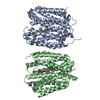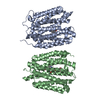+ Open data
Open data
- Basic information
Basic information
| Entry | Database: PDB / ID: 8tgk | ||||||
|---|---|---|---|---|---|---|---|
| Title | VMAT1 dimer with histamine and reserpine | ||||||
 Components Components | Chromaffin granule amine transporter | ||||||
 Keywords Keywords |  MEMBRANE PROTEIN / VMAT / SLC18 / vascular monoamine transporter / monoamines / neurotransmitters / MEMBRANE PROTEIN / VMAT / SLC18 / vascular monoamine transporter / monoamines / neurotransmitters /  histamine histamine | ||||||
| Function / homology |  Function and homology information Function and homology informationmonoamine:proton antiporter activity / norepinephrine uptake / dopamine uptake / aminergic neurotransmitter loading into synaptic vesicle / clathrin-sculpted monoamine transport vesicle membrane / serotonin:sodium:chloride symporter activity / serotonin uptake / Na+/Cl- dependent neurotransmitter transporters / monoamine transmembrane transporter activity / monoamine transport ...monoamine:proton antiporter activity / norepinephrine uptake / dopamine uptake / aminergic neurotransmitter loading into synaptic vesicle / clathrin-sculpted monoamine transport vesicle membrane / serotonin:sodium:chloride symporter activity / serotonin uptake / Na+/Cl- dependent neurotransmitter transporters / monoamine transmembrane transporter activity / monoamine transport / xenobiotic transmembrane transporter activity / secretory granule membrane /  terminal bouton / synaptic vesicle membrane / presynapse / endoplasmic reticulum membrane terminal bouton / synaptic vesicle membrane / presynapse / endoplasmic reticulum membraneSimilarity search - Function | ||||||
| Biological species |   Homo sapiens (human) Homo sapiens (human) | ||||||
| Method |  ELECTRON MICROSCOPY / ELECTRON MICROSCOPY /  single particle reconstruction / single particle reconstruction /  cryo EM / Resolution: 3.7 Å cryo EM / Resolution: 3.7 Å | ||||||
 Authors Authors | Ye, J. / Liu, B. / Li, W. | ||||||
| Funding support |  United States, 1items United States, 1items
| ||||||
 Citation Citation |  Journal: Nature / Year: 2024 Journal: Nature / Year: 2024Title: Structural insights into vesicular monoamine storage and drug interactions. Authors: Jin Ye / Huaping Chen / Kaituo Wang / Yi Wang / Aaron Ammerman / Samjhana Awasthi / Jinbin Xu / Bin Liu / Weikai Li /   Abstract: Biogenic monoamines-vital transmitters orchestrating neurological, endocrinal and immunological functions-are stored in secretory vesicles by vesicular monoamine transporters (VMATs) for controlled ...Biogenic monoamines-vital transmitters orchestrating neurological, endocrinal and immunological functions-are stored in secretory vesicles by vesicular monoamine transporters (VMATs) for controlled quantal release. Harnessing proton antiport, VMATs enrich monoamines around 10,000-fold and sequester neurotoxicants to protect neurons. VMATs are targeted by an arsenal of therapeutic drugs and imaging agents to treat and monitor neurodegenerative disorders, hypertension and drug addiction. However, the structural mechanisms underlying these actions remain unclear. Here we report eight cryo-electron microscopy structures of human VMAT1 in unbound form and in complex with four monoamines (dopamine, noradrenaline, serotonin and histamine), the Parkinsonism-inducing MPP, the psychostimulant amphetamine and the antihypertensive drug reserpine. Reserpine binding captures a cytoplasmic-open conformation, whereas the other structures show a lumenal-open conformation stabilized by extensive gating interactions. The favoured transition to this lumenal-open state contributes to monoamine accumulation, while protonation facilitates the cytoplasmic-open transition and concurrently prevents monoamine binding to avoid unintended depletion. Monoamines and neurotoxicants share a binding pocket that possesses polar sites for specificity and a wrist-and-fist shape for versatility. Variations in this pocket explain substrate preferences across the SLC18 family. Overall, these structural insights and supporting functional studies elucidate the mechanism of vesicular monoamine transport and provide the basis to develop therapeutics for neurodegenerative diseases and substance abuse. | ||||||
| History |
|
- Structure visualization
Structure visualization
| Structure viewer | Molecule:  Molmil Molmil Jmol/JSmol Jmol/JSmol |
|---|
- Downloads & links
Downloads & links
- Download
Download
| PDBx/mmCIF format |  8tgk.cif.gz 8tgk.cif.gz | 154.6 KB | Display |  PDBx/mmCIF format PDBx/mmCIF format |
|---|---|---|---|---|
| PDB format |  pdb8tgk.ent.gz pdb8tgk.ent.gz | 119.6 KB | Display |  PDB format PDB format |
| PDBx/mmJSON format |  8tgk.json.gz 8tgk.json.gz | Tree view |  PDBx/mmJSON format PDBx/mmJSON format | |
| Others |  Other downloads Other downloads |
-Validation report
| Arichive directory |  https://data.pdbj.org/pub/pdb/validation_reports/tg/8tgk https://data.pdbj.org/pub/pdb/validation_reports/tg/8tgk ftp://data.pdbj.org/pub/pdb/validation_reports/tg/8tgk ftp://data.pdbj.org/pub/pdb/validation_reports/tg/8tgk | HTTPS FTP |
|---|
-Related structure data
| Related structure data |  41239MC  8tggC  8tghC  8tgiC  8tgjC  8tglC  8tgmC  8tgnC M: map data used to model this data C: citing same article ( |
|---|---|
| Similar structure data | Similarity search - Function & homology  F&H Search F&H Search |
- Links
Links
- Assembly
Assembly
| Deposited unit | 
|
|---|---|
| 1 |
|
- Components
Components
| #1: Protein | Mass: 50565.641 Da / Num. of mol.: 2 / Mutation: residues 69-123 deleted Source method: isolated from a genetically manipulated source Source: (gene. exp.)   Homo sapiens (human) / Gene: SLC18A1, VAT1, VMAT1 / Production host: Homo sapiens (human) / Gene: SLC18A1, VAT1, VMAT1 / Production host:   Komagataella pastoris (fungus) / References: UniProt: P54219 Komagataella pastoris (fungus) / References: UniProt: P54219#2: Chemical | ChemComp-HSM / |  Histamine Histamine#3: Chemical | ChemComp-YHR / | Has ligand of interest | Y | |
|---|
-Experimental details
-Experiment
| Experiment | Method:  ELECTRON MICROSCOPY ELECTRON MICROSCOPY |
|---|---|
| EM experiment | Aggregation state: PARTICLE / 3D reconstruction method:  single particle reconstruction single particle reconstruction |
- Sample preparation
Sample preparation
| Component | Name: Complex of VMAT1 dimer with histamine and Reserpine / Type: COMPLEX / Entity ID: #1 / Source: RECOMBINANT |
|---|---|
| Molecular weight | Value: 0.1052 MDa / Experimental value: NO |
| Source (natural) | Organism:   Homo sapiens (human) Homo sapiens (human) |
| Source (recombinant) | Organism:   Komagataella pastoris (fungus) Komagataella pastoris (fungus) |
| Buffer solution | pH: 8 |
| Specimen | Embedding applied: NO / Shadowing applied: NO / Staining applied : NO / Vitrification applied : NO / Vitrification applied : YES : YES |
| Specimen support | Grid material: COPPER / Grid mesh size: 300 divisions/in. / Grid type: Quantifoil R1.2/1.3 |
Vitrification | Cryogen name: ETHANE |
- Electron microscopy imaging
Electron microscopy imaging
| Experimental equipment |  Model: Titan Krios / Image courtesy: FEI Company |
|---|---|
| Microscopy | Model: TFS KRIOS |
| Electron gun | Electron source : :  FIELD EMISSION GUN / Accelerating voltage: 300 kV / Illumination mode: FLOOD BEAM FIELD EMISSION GUN / Accelerating voltage: 300 kV / Illumination mode: FLOOD BEAM |
| Electron lens | Mode: BRIGHT FIELD Bright-field microscopy / Nominal magnification: 130000 X / Nominal defocus max: 2000 nm / Nominal defocus min: 1000 nm / Cs Bright-field microscopy / Nominal magnification: 130000 X / Nominal defocus max: 2000 nm / Nominal defocus min: 1000 nm / Cs : 2.7 mm / C2 aperture diameter: 50 µm / Alignment procedure: COMA FREE : 2.7 mm / C2 aperture diameter: 50 µm / Alignment procedure: COMA FREE |
| Specimen holder | Cryogen: NITROGEN / Specimen holder model: FEI TITAN KRIOS AUTOGRID HOLDER / Temperature (max): 77.2 K / Temperature (min): 63 K |
| Image recording | Average exposure time: 2 sec. / Electron dose: 50 e/Å2 / Film or detector model: GATAN K3 BIOQUANTUM (6k x 4k) / Num. of grids imaged: 1 / Num. of real images: 6166 |
| EM imaging optics | Energyfilter name : GIF Bioquantum / Energyfilter slit width: 20 eV : GIF Bioquantum / Energyfilter slit width: 20 eV |
- Processing
Processing
| EM software | Name: PHENIX / Version: 1.20.1_4487: / Category: model refinement | ||||||||||||||||||||||||
|---|---|---|---|---|---|---|---|---|---|---|---|---|---|---|---|---|---|---|---|---|---|---|---|---|---|
CTF correction | Type: PHASE FLIPPING AND AMPLITUDE CORRECTION | ||||||||||||||||||||||||
| Symmetry | Point symmetry : C1 (asymmetric) : C1 (asymmetric) | ||||||||||||||||||||||||
3D reconstruction | Resolution: 3.7 Å / Resolution method: FSC 0.143 CUT-OFF / Num. of particles: 110835 / Symmetry type: POINT | ||||||||||||||||||||||||
| Refine LS restraints |
|
 Movie
Movie Controller
Controller










 PDBj
PDBj







